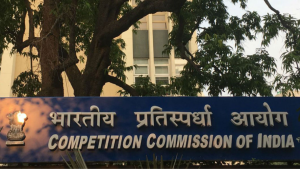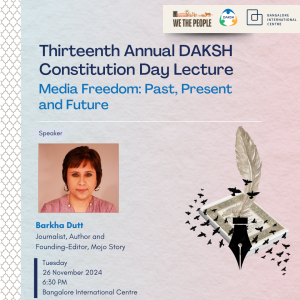

India’s first sedition trial and age of consent
- Leah
- /
- The DAKSH Podcast /
- India’s first sedition trial and age of consent
The role of the state in reforming religious and social practices is a subject of heated debate in India. This is especially so when such reforms involve claims of women. A recent example is a debate around marital rape. In this episode, we go back more than 130 years and examine the reactions to the British government increasing the age of consent for women from 10 to 12 years and how these led to India’s first sedition trial.
If you like our podcast do consider supporting us with a donation at the link below: https://www.dakshindia.org/donate/
Show Notes
-
Support us by Donating.
-
Chitranshul Sinha, The Great Repression India, Viking 2019
-
IshitaPande, “Phulmoni’s body: the autopsy, the inquest and the humanitarian narrative on child rape in India.” South Asian History and Culture 4.1 (2013): 9-30.
-
Queen-Empress vs Hurree Mohun Mythee (1891) ILR 18 Cal 49 https://indiankanoon.org/doc/1410526/
This episode contains descriptions of sexual violence. Listener discretion is advised.
Hello, and welcome to the DAKSH podcast. I’m your host Leah. As many of you may know or may not know, India sedition law is under challenge before the Supreme Court. Another interesting challenge before the court relates to marital rape. The two cases have a not widely known but interesting historical connection. India’s first sedition case has its roots in debates on the age of consent for women and marital rape. It arose out of heated discussions on the state’s role in reforming religious practices. Some of the questions on the state’s role in religion are still being debated today, not just in courts, but also on the streets. This short episode will explore India’s first sedition case and the case of the death of Phulmoni Das.
Let’s start with understanding what the word ‘sedition’ means. The most basic dictionary definition of sedition is the offense of saying or doing anything that incites violence against the state. You will be familiar with the term because dissenters and opponents of ruling parties in India often get arrested for sedition. Now, let’s look at what sedition means legally. Sedition was added as section 124A of the Indian Penal Code in 1870, 10 years after the original Act was passed. The section criminalized spoken, written or any other form of visible representation of hatred or contempt towards the crown, or the legally established government in British India. Any form of speech that instigated disloyalty or rebellion against the government could also be interpreted as seditious. The law has its roots in English common law. The Sedition Act of 1661 in England sought to punish anyone who wrote, printed or preached any words against the king. The British colonial government was quite frank about the fact that the reason for importing sedition from English law was to prevent criticism of its regime. the drafter of the Sedition amendment, James Fitz James Stephen, in typical British arrogance said without a hint of irony, “Language that may be tolerated in England will not be tolerated in India because it may lead to violence.”
Sedition of course played a role in suppressing nationalist voices in colonial India as it was intended to.
A famous example is that of the Tilak sedition trial. A lesser examined story is the tension between sedition law and social reform, India’s first ever sedition case. Queen Empress v. Jogendra Chunder Bose in 1891, brought forth this tension and also tested the limits of the sedition law. In this case, the editor and publishers of the Bengali newspaper Bangobashi were tried for their articles denouncing the Age of Consent Act. This Act increased the age of consent of girls from 10 to 12 years. The age of consent is the age at which a woman is considered to be mature enough to consent to sexual intercourse. In other words, sexual intercourse with a woman below that age is considered rape irrespective of consent. In their articles about this law, Bangobashi used very strong anti English statements, which is why they were being tried for sedition.
Why did these articles make the British regime so nervous? The story of the colonial government introducing social reform in India is complicated. So let’s set some historical context here. The late 19th century witnessed the rise of nationalism and social reform movements all over India. India was then being administered directly by the British Crown after the revolt of 1857. Queen Victoria’s famous proclamation in 1858, laid out an official policy of non intervention in existing Indian law, especially in religious law. There were certain practices however, that the British could not turn a blind eye to. This led to confrontations with groups and individuals who were against such interference. Child marriage was one such practice. The case of Phulmoni Das brought this issue to the fore in 1889. Full money thus, a 10 year old child bride in Bengal died after sexual intercourse with a much older husband. The case was heard by the Calcutta High Court in 1894. Phulmoni’s husband, Hari Mohan Maitee, was charged with culpable homicide. Culpable homicide is the equivalent of manslaughter in the US for those of you who are familiar with American TV shows. It involves causing the death of a person either with the intention of causing death or with the knowledge that it is likely to cause death. Hari Mohan could not be accused of rape since marital rape was not a crime then, sadly, it is still not a crime. Phulmoni was not only above the then age of consent, but was also married to the accused person. The judgment in the Phulmoni case needs a trigger warning. It goes into graphic detail about Phulmoni’s body and the injuries caused to it. Unfortunately, in those days, names of minors involved in sexual assault cases were not kept private. Hari Mohan was charged with four offenses, culpable homicide not amounting to murder, voluntarily causing grievous hurt, causing death by a rash and negligent act and causing grievous hurt by an act so rashly or negligently done as to endanger life. He was finally convicted only for the last offense and sentenced to one year’s rigorous imprisonment. The case became breaking news at the time. If news channels from 2022 time travel to 1891, they would have hosted news debates with 20 guests in little squares shouting at each other about this case.
Hari Maiteeism became shorthand for the practice of consummating marriages with young girls. The news reached the UK too. Between 1888 and 1889, the British newspaper ‘The Times’ included more than a dozen long articles describing the evils of child marriage in India. They cited cases of young girls mistreated by their husbands and mothers in law. One of these was a story in the times of 17 September 1888, about a girl aged about 11, being branded by her mother in law. The colonial government began to consider increasing the age of consent. This angered various Hindu traditionalists, including Tilak, who had a firmly nationalist and anti-colonial perspective on the issue. To be clear, his stand was not in support of child marriage. However, they wanted the change to come through social reform and criticize the imposition of English ethics and morals on Indian life. The language used to criticize the bill may sound archaic, but these sentiments are echoed in contemporary debates on state interference and religion. Here are a few examples. The Age of Consent Bill was described in the ‘Marathi Weekly’ in Maratha as “the thin edge of the wedge of increasing government interference with religion”. A. Shankaraiya, President and founder of the Hindu Sabha in Thrissur, said in a letter to the Secretary of the legislative department rather dramatically, it was a 1000 times better for one out of 10,000 girls to suffer from the hasty indiscretion of a husband than for several girls to be defiled and outcasted by an invasion of their persons by strangers. The anger spread to the streets.
On 18th March at 1891, a day before the final reading of the bill in the Legislative Council, a crowd of two to 3000 people gathered at the Shobhabazar Rajbari in Calcutta to protest against the bill. The bill was passed despite the protest and the age of consent was raised to 12 years. Needless to say, this law hit the headlines. In the late 19th century, the press was becoming quite influential in India. By 1875, there were about 475 newspapers in circulation in Bengal alone. Bangobashi was one of them, a weekly with a circulation of about 30,00. Three articles criticizing the age of consent act in Bangobashi, resulted in India’s first ever sedition trial. These articles accused the British government of Europeanising India by brute force. The articles also raised the cry of religion in danger. One article said, in enacting the consent Act, the English had been drawn into the vortex of circumstances that have been applied to the cost of both the mask and the slough. Now stands before us the severe, terrible, disgusting naked form of the Englishman. Our heart trembles at the sight of this form as Sita was to find on seeing the great ascetic wearing the guise of a mendicant transformed himself suddenly into the 10 headed 20-eyed king of the rakshasas. So we have been stupefied by fear, by wonder, by contempt, by insult. Another article warned that Aurangzeb and Kalapahad had failed in affecting the minds of the Indians, and the British would also fail. In case you’re wondering who Kalapahad is, he was a Muslim general from Bengaluru, who was supposed to have attacked the Jagganath temple in Orissa. The British government was not amused by these articles and predictably filed a case of sedition against the editor of Bangobashi. The question in the trial was twofold. Firstly, what truly constituted a violation of Section 124A, and secondly, did the actions of the publishers fall under that umbrella. The prosecution could not figure out who the authors of the article were. The defense argued that publishers could not be tried for the actions of authors, since publishers were not explicitly included under Section 124. A. The second argument went to the heart of the meaning of sedition and echoes debates happening in Indian courts today. The defense argued that the published words amounted to a mere disapprobation of the age of consent law, and not actual enmity towards the government. Disapprobation is a fancy legal term for disapproval. The judge, in his instructions to the jury, said that fostering feelings of hatred or contempt and disaffection against the government was different from a mere disapproval of the government’s actions. A mere disapproval of certain actions or policies of the government would not be seditious. The jury could not come to a unanimous conclusion, and the case was dismissed for a retrial.
Since then, several courts have interpreted the Sedition provision in different ways. The Supreme Court, in a 1962 judgment declared the provision constitutional. On the date of this episode’s recording, that is 26 September 2022, the constitutionality of the Sedition provision is once again under challenge. With regards to the age of marriage, currently for Hindu women it is 18 years and for Muslim women, it is 15 years. Child marriage is voidable but not void. That means that unless the woman in question asked for the marriage to be annulled, it remains valid. The issue of whether marital rape is a crime is still being debated, and the matter is before the Supreme Court.
Thanks for listening. If you’d like to know more, write to us at info@dakshindia.org or comment on our social media pages. We will be happy to bring you more episodes like this. Special thanks to Gian Chatterjee for his research assistance. If you enjoyed the episode, do consider supporting us with a donation. The link is in the show notes below. Creating this podcast takes effort and your support will help us sustain a space for these quality conversations. To find out more about us and our work visit our website dakshindia.org, that’s D-A-K-S-H india.org. Don’t forget to tap, follow or subscribe to us wherever you listen to your podcast so that you don’t miss an episode. We would love to hear from you so, do share your feedback either by dropping us a review or rating the podcast where podcast apps allow you to. Talk about it on social media. We’re using the hashtag DAKSH podcast. It really helps to get the word out there. Most of all, if you found some useful information that might help a friend or family member, share the episode with them. A special thank you to our production team at ‘Maed in India’, our production head Niketana K, edited, mixed and mastered by Lakshman Parshuram and project supervision by Sean Phantom.
RECENT UPDATE


Thirteenth Annual DAKSH Constitution Day Lecture

Not Quite Rocket Science

Administration of justice needs an Aspirational Gatishakti

-
Rule of Law ProjectRule of Law Project
-
Access to Justice SurveyAccess to Justice Survey
-
BlogBlog
-
Contact UsContact Us
-
Statistics and ReportsStatistics and Reports
© 2021 DAKSH India. All rights reserved
Powered by Oy Media Solutions
Designed by GGWP Design